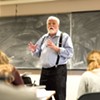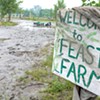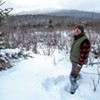Switch to the mobile version of this page.
Vermont's Independent Voice
- News
- Arts+Culture
- Home+Design
- Food
- Cannabis
- Music
- On Screen
- Events
- Jobs
- Obituaries
- Classifieds
- Personals
Browse News
Departments
-
Education

Scott Official Pushes Back on Former State…
-
News

Burlington Budget Deficit Balloons to $13.1 Million
-
Education

Senate Committee Votes 3-2 to Recommend Saunders…
- Court Rejects Roxbury's Request to Block School Budget Vote Education 0
- Norwich University Names New President Education 0
- Media Note: Mitch Wertlieb Named Host of 'Vermont This Week' Health Care 0
Browse Arts + Culture
View All
local resources
Browse Food + Drink
View All
Browse Cannabis
View All
-
Culture

'Cannasations' Podcaster Kris Brown Aims to 'Humanize'…
-
True 802

A Burlington Cannabis Shop Plans to Host…
-
Business

Judge Tosses Burlington Cannabiz Owner's Lawsuit
-
Health + Fitness

Vermont's Cannabis Nurse Hotline Answers Health Questions…
-
Business

Waterbury Couple Buy Rare Vermont Cannabis License
Browse Music
View All
Browse On Screen
Browse Events
Browse Classifieds
Browse Personals
-

If you're looking for "I Spys," dating or LTRs, this is your scene.
View Profiles
Special Reports
Pubs+More
Three and a Half Feet Under: Cemeteries Are Wary of Green Burials
Published July 19, 2017 at 10:00 a.m.
Fred Cheyette plans to be buried in a hayfield next to his house in the town of Orange. His body will be wrapped in a simple cotton sheet and placed three and a half feet deep in the earth, with an oak sapling planted atop the grave.
"So my body feeds the tree," said the 86-year-old retired engineer and psychotherapist, who is peppier and more youthful looking than his years suggest.
Cheyette has arranged what is known as a green, or natural, burial — rejecting the standard procedures of cemetery interments. There will be no embalming, no varnished coffin, no concrete vault, no polished headstone. He wants his body in the dirt and close to the surface.
Despite a state law that took effect this month to make it easier for Vermonters to choose a green burial, Cheyette's arrangements are possible only because he will be buried on his own property. He received permission from his town's Board of Health.
For others, planning a natural burial poses greater challenges: Advocates of green burials say they know of no cemeteries in Vermont that yet allow the green interments they envision.
Passing the new law — which allows burials at a mere three and a half feet, where a more active biological soil mix facilitates rapid and natural decomposition — appears to have been the easy part. Now, supporters of the practice have to persuade dozens of cemetery operators to change policies. Many Vermont cemeteries require a five-foot burial depth and that coffins be placed inside buried concrete vaults, rules that preclude the simpler burials.
But Michelle Acciavatti of Montpelier and a half dozen other green-burial advocates stand ready to convince cemetery operators to change their policies. They are forming a nonprofit organization, Green Burial Vermont, which will produce a manual of best practices.
"The goal of the nonprofit is promoting environmental and socially conscious burials in Vermont," Acciavatti said.
The group's efforts could change the traditional image of graveyards.
Carl Anderson of West Berkshire, a wildlife biologist who is a member of Green Burial Vermont, said he envisions existing cemeteries adding green sections, as well as new graveyards that will use proceeds from the sale of natural plots to conserve surrounding acres. The dead could share space with sugaring operations, tree farms or hayfields.
But first, the organization has to allay a host of fears: that coyotes would scavenge for shallower, unprotected bodies; that some types of soils would inhibit decomposition; and that changing the layout of a graveyard to something other than rows of mowed grass dotted with shiny headstones would pose logistical challenges.
"There are just unknowns," said Patrick Healy, manager of Montpelier's city cemeteries and president of the Vermont Cemetery Association. "We just want to know what the best practices are."
"A lot of the pushback is coming from the cemetery operators," said Acciavatti, who toured the state last fall and winter advocating for the legal change. "There are a lot of misconceptions."
For Acciavatti, 34, dealing with death is a passion and a vocation. She runs a business called Ending Well, which offers end-of-life planning and counseling. She's also a hospice volunteer and co-facilitates a monthly "death café" in Montpelier, where attendees sip tea and converse about mortality.
She set out to become a neuroscientist. Then two close friends died in accidents shortly after she graduated from college. A year later, she was in a close-call crash herself.
"The first thing the trooper said was, 'You're so lucky you didn't die.' That percolated inside me for a while," Acciavatti said. Before she knew it, Acciavatti was making a business of the thing most people don't want to talk about.
With a soothing, nonjudgmental manner, Acciavatti manages to make talking about death easy. She hopes to take such conversations out of the shadows and into living rooms and dining rooms. "I used to joke that I was constantly ruining holiday dinners," she said. "Now I'm everybody's death friend."
On a beautiful Tuesday evening in June, a dozen like-minded people gathered at a Montpelier tea shop for the death café. Heavy at times, the conversation also focused on uplifting moments families share as a loved one approaches the end.
Cheyette is a regular attendee. He readily shared plans for his own burial. Having what he sees as an environmentally friendly afterlife plan is a comfort, he told the group.
He, too, wants to change the notion that death is a taboo topic. "It makes me feel alive," he said later, of the death café discourse. "I feel really good when I leave there."
Acciavatti said green burials pair well with her desire to open up discussion about death. "We've become so cut off from death," she said. "It's been medicalized. It's been commercialized. It's been taken out of the home."
In a traditional burial, an embalmed corpse is placed in a casket, which is then lowered five feet deep into a concrete vault and covered. The body decomposes, but the lack of contact with soil slows the process, wildlife biologist Anderson said. In the meantime, water interacts with the casket's metal, varnish and paint, which pose a risk of contaminating groundwater, he said.
Green burials are intended to bring the body into closer contact with the soil. The unembalmed corpse is buried with no casket or in an unadorned wooden coffin. There is no concrete vault. Decomposition of soft tissue typically takes place within two years, depending on soil and hydrology, though bones take longer, Anderson said.
"With a green burial, you're trying to put the body as close to active biological layers as you can without letting scavengers get at it," he said. Hundreds of green-burial sites around the country do that at three and a half feet, without a scourge of scavengers, he noted. Vermont requires that deceased livestock be buried under two feet of soil.
But convincing cemetery operators to change their policies will take time, said Calais cemetery commissioner Jennifer Whitman. She joined the movement after hearing Acciavatti speak and would like her town to allow natural burials.
"This is a slow process," Whitman said. "This is going to be the next 10 years."
Just collecting contact information for the many cemetery operators throughout the state was a challenge, she said. Now, Green Burial Vermont's goal is to help them work through logistical concerns.
People have many definitions of what constitutes a green burial, Whitman noted. Some want to be buried in the woods with no markers; others prefer a plain pine box in a shallow grave with a natural gravestone. Each cemetery's operators have to figure out what they can accommodate, Whitman said.
Cemetery commissions would have to change long-standing policies, such as requirements for concrete vaults. Calais has such a rule, Whitman said.
That policy exists for good reason — to keep graves and caskets from collapsing, Healy said. When workers dig graves and mow cemetery grass, they often use heavy machinery, he noted.
Healy said that practice is one of the concerns he has about reserving part of a cemetery for green burials. He is not persuaded that wild animals won't dig up natural graves, though advocates insist the fear is unfounded. And he wonders what the protocol would be for transporting a body to a gravesite without a casket.
"Will the public be able to handle seeing bodily fluids on shrouds?" he asked.
Nevertheless, Healy has had requests for green burials, and the Montpelier Cemetery Commission is considering what to do. One option is to phase in changes. "I think our first step may be pine boxes without vaults," he said.
The Burlington Cemetery Commission is pondering the same questions.
"I would like to do more research and see if there's a way to make it possible," said cochair Allison Curran.
Burlington requires vaults and a five-foot grave depth at its two active cemeteries, Lakeview and Greenmount. Last week, Acciavatti asked the city commission for an exemption for a terminally ill client who wants a green burial. Commissioner Emma Swift expressed reservations about granting exemptions before setting a green burial policy, according to minutes of the meeting. The panel plans to consult the city's attorney.
Meetinghouse Hill Cemetery in West Brattleboro may come closest to offering a green-burial option. The graveyard has a separate section where vaults and embalming are not required, manager Andrea Mitchell said. Three bodies have been buried there.
To the chagrin of green-burial advocates, however, the cemetery is unwilling to place bodies at depths of less than five feet. "The fella that digs our graves doesn't want it, and I don't want it. I think it's too shallow," Mitchell said. Asked why, she said, "I don't know, but I don't want to find out."
Meetinghouse Hill charges $1,000 for a green plot, more than the $700 for a traditional one, because maintaining gravesites that are more prone to sinking is expected to be an additional challenge, Mitchell said.
If green burials gain traction in Vermont, the trend could give cemeteries a needed boost. Business is lagging, Healy conceded, as more Vermonters opt for cremation. Cemeteries are encouraging families to bury cremated remains, he said, but many choose to scatter or keep the ashes.
According to the Vermont Department of Health, slightly more than two-thirds of Vermont's dead were cremated in 2014. Green burial advocates say cremation generates too much greenhouse gas.
Chris Palermo, owner of Perkins-Parker Funeral Home in Waterbury and president of the Vermont Funeral Directors Association, said that when he started in the business 40 years ago, about 15 percent of his customers chose cremation. Now, he said, 80 percent do.
He's not yet had any customers ask for a green burial, but Palermo said he supports giving families the options they seek. Most importantly, he said, people should tell their families what they want, because, too often, they don't.
"My sense is, people are becoming more comfortable with the discussion," he said.
Cheyette is at ease talking about such matters. His wife, Sage Blue, who died in 2004, was cremated. Cheyette spread her ashes on their property, he said.
He hasn't shared his burial plan with his three children but said he met with a group of close friends to explain what he wants. "It's also posted on my refrigerator," he said, next to his advance directive and do-not-resuscitate orders.
He explained why he wants his remains to nourish an oak tree. "I don't want my body to be wasted," he said.
Related Stories
Got something to say?
Send a letter to the editor
and we'll publish your feedback in print!
More By This Author
About The Author

Terri Hallenbeck
Bio:
Terri Hallenbeck was a Seven Days staff writer covering politics, the Legislature and state issues from 2014 to 2017.
Terri Hallenbeck was a Seven Days staff writer covering politics, the Legislature and state issues from 2014 to 2017.
Speaking of...
-

Waking Windows Announces 2024 Lineup
Apr 12, 2024 -

Vermont Drummer Urian Hackney Is on a Wild Ride Through the Rock World
Aug 23, 2023 -

A Brooklyn Comedian Brings His Death-Themed Standup Act to a Winooski Funeral Home
Jun 7, 2023 -

Peter Miller, Iconic Vermont Photographer, Dies at 89
Apr 20, 2023 -

Rick Ames Brings His One-Man Show About Cemeteries to Burlington
Apr 19, 2023 - More »
Comments (4)
Showing 1-4 of 4
Comments are closed.
From 2014-2020, Seven Days allowed readers to comment on all stories posted on our website. While we've appreciated the suggestions and insights, right now Seven Days is prioritizing our core mission — producing high-quality, responsible local journalism — over moderating online debates between readers.
To criticize, correct or praise our reporting, please send us a letter to the editor or send us a tip. We’ll check it out and report the results.
Online comments may return when we have better tech tools for managing them. Thanks for reading.
- 1. Scott Official Pushes Back on Former State Board of Ed Chair's Testimony Education
- 2. Burlington Budget Deficit Balloons to $13.1 Million News
- 3. Home Is Where the Target Is: Suburban SoBu Builds a Downtown Neighborhood Real Estate
- 4. Legislature Advances Measures to Improve Vermont’s Response to Animal Cruelty Politics
- 5. A Former MMA Fighter Runs a Wildlife Rehabilitation Center in Cabot News
- 6. Vermont Rep. Emilie Kornheiser Sees Raising Revenue as Part of Her Mission Politics
- 7. Senate Committee Votes 3-2 to Recommend Saunders as Education Secretary Education
- 1. Totally Transfixed: A Rare Eclipse on a Bluebird Day Dazzled Crowds in Northern Vermont 2024 Solar Eclipse
- 2. Zoie Saunders, Gov. Scott’s Pick for Education Secretary, Faces Questions About Her Qualifications Education
- 3. Don't Trash Those Solar Eclipse Glasses! Groups Collect Them to Be Reused 2024 Solar Eclipse
- 4. State Will Build Secure Juvenile Treatment Center in Vergennes News
- 5. Vermont Awarded $62 Million in Federal Solar Incentives News
- 6. Queen of the City: Mulvaney-Stanak Sworn In as Burlington Mayor News
- 7. New Jersey Earthquake Is Felt in Vermont News


























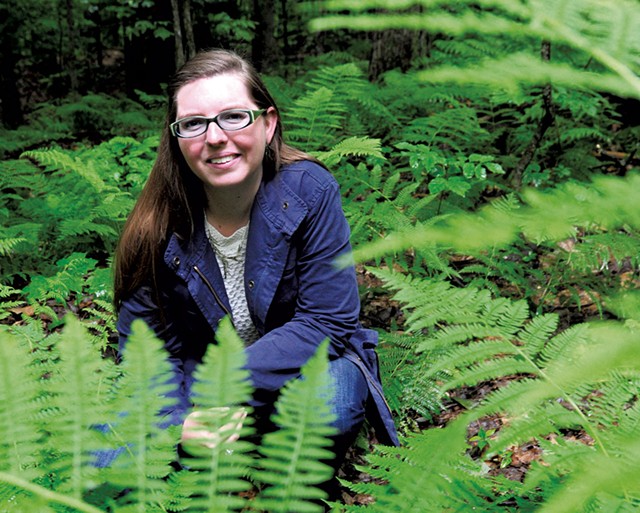
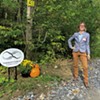
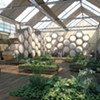



![Lakeview Cemetery Tour [SIV509]](https://media2.sevendaysvt.com/sevendaysvt/imager/u/square/9497832/episode509.jpg)




